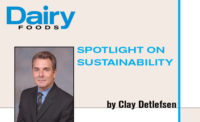In 2008, the U.S. dairy industry came together at a sustainability summit and made a commitment to engage in a variety of projects with the goal of reducing greenhouse gas emissions. In 2009 the industry collectively committed to a voluntary greenhouse gas emission reduction of 25% by 2020.
Greenhouse gases are a significant measure of energy usage, especially on the processing side of the dairy industry. So a greenhouse gas reduction of 25% for processors is in essence an energy reduction or savings of 25%. With six years left to go, will we be able to pull it off? Tough call, but I think it is achievable.
In January 2010, the International Dairy Foods Association and the Environmental Protection Agency signed a memorandum of understanding to work together to assist the dairy processing industry to improve its energy efficiency or otherwise save energy. First we collaborated on a dairy industry energy management guide entitled “Energy Efficiency Improvement and Cost Saving Opportunities for the Dairy Processing Industry, An Energy Star Guide for Energy and Plant Managers.” Perhaps that is not the catchiest of titles, but it’s a solid tool and a great reference for information on energy use in the dairy industry.
A challenge to be 10% better
Around the same time as that, we were working with Energy Star on its Challenge for Industry, a perennial favorite of mine. The challenge program is simple: calculate your plant’s energy intensity — a measure of your energy efficiency — and challenge yourself to be 10% more efficient within five years.
Today, 655 industrial facilities have signed up for the challenge. Approximately 120 of those facilities are dairy processing plants; other significant industries involved include the baking, paper, consumer goods and automotive industries. Of the 655 plants that have signed up, 244 plants have already achieved their 10% reduction; 29 are dairy plants. Dean Foods, The Kroger Co. and Saputo Cheese USA were able to meet the challenge, with at least one plant each turning in a reduction of more than 20%. Congratulations, guys.
I suspect more dairy plants have achieved the 10% reduction but have yet to file the paperwork with EPA, or EPA is processing their results. But at any rate, you can see that we can and are making great progress.
As many wrap up the challenge in the next year or so, keep in mind that achieving the challenge does not preclude an industrial facility from taking the challenge again. I encourage people to do so.
EPIs, the next big thing in measurement
With the challenge largely under our belts, what’s next is exciting. EPA’s Energy Star has created energy performance indicators (EPIs) for 11 industries and dairy will soon make that 12. The EPIs are the benchmark of your plant’s performance compared to the overall industry’s performance. The EPIs for each industry are created by a team at Duke University using industry’s confidential data on plant production and energy purchases as reported by U.S. manufacturing plants to the U.S. Census Bureau as part of its Census of Manufacturers.
An individual plant enters its data into an EPI spreadsheet and the resultant benchmark score is revealed. The score is given on a scale of 1 to 100, with 100 being the top performer. EPA will recognize and award the top 25% of plants in a given industry with its Energy Star Certification. Certified plants are awarded a congratulatory letter to the company’s CEO, a certificate of achievement, decals for identifying the plant’s certification, the option to obtain flags/banners/plaques, and a listing in EPA’s Energy Star certified plant registry. IDFA will of course let the industry know when this option becomes a reality and we are excited to do so.
Strides by Dean, Darigold, others
That is the big picture. But let’s take a look at what some individual companies are doing. In 2008 Dean Foods set an energy use reduction goal of 20% per gallon of product produced by 2020. In 2012, the company announced it had achieved a 9% energy reduction. In addition, Dean established a number of other sustainability goals and seems to be on target to meet those as well.
In 2010, Darigold issued its first cooperative social responsibility report (CSR) and its second in 2012. The 2010 CSR included a number of energy goals, specifically a 2.5% electricity reduction per unit per year, and a 2.5% reduction of natural gas per unit per year. In the 2012 CSR, Darigold reported it had achieved 5.1% in electricity reduction and 5.8% in natural gas reductions and was on target for an overall reduction of 25% by 2020 for each of these metrics. Like Dean Foods, Darigold has many other metrics and goals, and they to seem to be on target across the board.
Numerous other dairy industry companies and cooperatives, like Glanbia, Danone, Unilever and too many others to name here are heavily engaged in sustainability and social responsibility and if we had the space in this column, I’d dig into their numbers, too. But based on the good work that is going on in our dairy processing facilities, I know that as an industry we are moving towards the 25% greenhouse gas emissions target. That will produce a nice energy savings as well.




